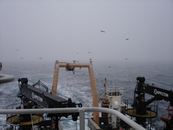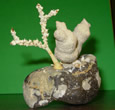

Have any NOAA ships been destroyed or wrecked?
(A question from Charlie, answered by Captain Mike)
No NOAA ships have been destroyed or wrecked. Accidents, however, do occur. In 2006, the Oscar Dyson while transiting the Inside Passage in British Columbia ran onto a shoal area in a narrow channel. One of the blades of the propeller was sheared off when the blade hit the rock shoal. The resulting damaged required being placed in a drydock repair to fix the damage. In 2000, the Ronald H. Brown had an allision with an Inside Passage island's rocky shoal also resulting in damage requiring drydock repair.
What is the point of sending NOAA ships to sea?
( from Charlie, answered by Captain Mike)
NOAA has multiple survey mission and research priorities The NOAA ships provide a sea going platform to accomplish hydrographic surveys (chart water depth to update nautical charts), oceanographic and atmospheric research (to study climate change and pollution), and fisheries research vessels (to study fish stock population health and associated oceanography & ecology). Surveys aid safer navigation and research improves understanding of the earth’s processes and the ocean’s resources.
Has the Dyson been in any serious emergencies?
(from Clay answered by Dave Strausz, Science Technician at PMEL in Seattle)
The Dyson has not been in any serious emergencies to my knowledge. It has suffered from broken generators and other mechanical mishaps, but has always been able to make it back to port on its own power.
How long does a Bongo tow stay in the water?
(from Joey answered by Dave Strausz, Science Technician and Peggy Sullivan, Scientist at PMEL in Seattle)
The duration of a bongo tow varies in length. This is dependent on how deep the tow goes. The deeper the tow, the longer it takes to go down and then up again. We often do work in water that is less than 100 meters in depth and more typically 50 to 70 meters. We often do a Bongo Tow immediately before or after a CTD cast so the data sets compliment each other. By the time we set up the nets and get them in the water, tow,then out of the water with a winch, we spend at least twenty minutes and often 30-60 minutes at those depths.
Is 1,000 meters of ocean pressure strong enough to destroy a rock?
(from Steven answered by Dave Strausz, Science Technician at PMEL in Seattle)
1000 meters of pressure would not destroy a rock. The pressure is uniform all around the rock and the rock is solid. If the rock were hollow or porous (like a styrofoam cup) it might be crushed or change shape.
Would warmer water affect how big heads we sent to you were when they came back to the surface?
(from Jason answered by Dave Strausz, Science Technician at PMEL in Seattle)
The styrofoam heads you sent us will be shrunk down a great deal regardless of water temperature. Compression (or shrinkage) is primarily a factor of sea pressure. Temperature has an effect, but it is small enough, next to the large effect of pressure, that it is negligible. Good thinking, though, in observing and questioning many angles of a problem.
What was the largest animal caught by the Dyson crew?
(from Zach)
Occasionally we catch a salmon shark. This attachment (Word docx) has photos of one in a net among a bunch of sandfish and a few flatfish, not salmon! It must have been confused. We *try* to take a few measurements, look for tags, and then get them back into the water. We don’t like them on deck anymore than they like being on deck!
Is there a salvage arm onboard to bring things up from the sea floor?
(from Wyatt, answered by Chief Engineer Jeff)
We have two cranes on the ship one on the portside
(left) and another on the starboard (right). These can be used for
lifting things from the ocean but not like you would find on a Salvage
Ship. Most of the work we do that requires lifting is for buoys and
the weights that hold them to the ocean floor and they only weigh a
couple tons. We have a device on the stern (back) of the ship called
an "A" frame (because it looks like an A without the center bar). It is
used for lifting the nets or retrieving buoys and it can lift
10,000 pounds. Take a look at the pictures and see if you can spot the
A frame and cranes. Thanks For your question Wyatt. Chief
Engineer Jeff
 |
 |
 |
| The A Frame and two cranes are seen on the stern of the ship Oscar Dyson. Photos from Jeff, Chief Engineer | ||
Have waves ever damaged the ship?
(from Travis, answers from 2 crew members)
Answer 1: Yes, this ship sees some rough weather but as far as
significant damage incurred goes I'd have to give that to another ship
I sailed up in these waters called the Miller Freeman. We were in the
Shelikoff Straits, the weather was rough and I was on watch in the
engine room. The ship was rolling about 40 degrees and I was on the
lookout for anything that could give us cause to lose power which
would be very bad news. All the sudden the ship felt like it hit a
huge wall of clay or something for it slowed dramatically real quick,
at the same time water started raining down into the engine room.
well, that water is like liquid ice and everything it touched caused
it to turn to steam for there are a great many hot things in the
engine room. well, the ''rainfall'' didn't last long and the ship
hove to for the rest of the night (meaning we sort of hovered, didn't
go anywhere). The next day we discovered a wave had come up clear to
the top of the ship and caved in part of the ventilation system
allowing water to enter the ship. it also flooded parts of the
galley, caved in the port side bulwarks (railings) and split the deck
open on the port side at the main deck level where it meets the skin
of the ship. Yea, we got clobbered. after about 3 days with jacks and
welders we fixed the split deck and bulwarks, the rest got fixed that
winter during our inport shipyard break.
Not your typical cruise boat huh?
Answer 2: Yes we have been hit by some big waves that did some minor damage a
few years ago during a winter storm in the Bearing Sea we had some big
waves tear of the flood light on the front of the ship. If you see any
pictures of the ship when it was new you can see that it had four big
lights on the forward decks. Now we only have two you can see it was a
big wave to reach all the way up to those lights.
How long has it been known that styrofoam will shrink at 1,000 meters? (from Mary, answered by Peggy Sullivan, Scientist with Univ.of Washington, JISAO at PMEL in Seattle)
Mary, I was searching around for an answer to this question and learned many things. Styrofoam is actually expanded or foamed polystyrene. The American Chemistry Council says that polystyrene foam, or styrofoam cups are 95% air and 5% polystyrene. The air is trapped in pockets during the manufacure. This makes polystyrene very lightweight and insulating, good for hot drinks or as insulation in your walls, since air is a good insulator. The people who discovered and produced polystyrene were probably very aware of compressibility of the styrofoam because of the air pockets and molecular structure (your cups compress and shrink with high water pressure at depth). I think the inventors knew all along that styrofoam would shrink at high pressure, but I don't imagine they were thinking about cups deep in the ocean. Foamed polystyrene was created in the 1940's, though the cups came later.
What is the coolest rock you have found from the ocean floor? (from Oliver, answered by Peggy Sullivan, Scientist with Univ.of Washington, JISAO at PMEL in Seattle) [NOTE: < means "less than", > means "greater than"]
 |
| Rock with attached coral fromn a mooring cruise in the Aleutian Islands |
How many days do you usually stay at sea at a time? (from Logan, answered by Peggy Sullivan, Scientist with Univ.of Washington, JISAO at PMEL in Seattle)
For the scientists on our research cruises, the time at sea can last from a week to 2 months depending on the work that needs to be accomplished, and ship scheduling. On average, we are probably out 2-3 weeks for one cruise. The ship is our home during that time where we eat, sleep, and work 7 days each week. Some of us go out once or twice a year, some of us don't go out every year, and some of us, especially the people who do technical and equipment work, go out multiple times. There is an award at NOAA-PMEL called the "Old Salt" award that is given to the person who was out the most in a year. One of our people got the award for 149 days at sea. That is on many cruises, but that many days is 41% of a year!
How many King Crabs do you catch in a year? Have you ever come close to a trench? (from Candyse, answered by Peggy Sullivan)
King Crabs: Our project does not catch king crabs, but we have colleagues in NOAA who do catch them to study and estimate populations. So, they would not catch as many as fishermen on crab boats, but I really don't know how many..
Trenches: Although our interest and studies do not specifically focus on trenches, we often come close to the Aleutian Trench, also called the Aleutian Trough, which is on the North Pacific Ocean side of and somewhat parallel to the Aleutian Islands. It extends far west to Russian waters. The deepest part of the trench is 25,194 feet (7,679 meters) deep. Compare that number to Alaska's Mt. McKinley, which is 20,320 feet (6,194 meters) tall.
| EcoFOCI Project Office NOAA/PMEL and NOAA/AFSC |
|
| 7600 Sand Point Way NE Seattle, Washington 98115 Comments and information |
|